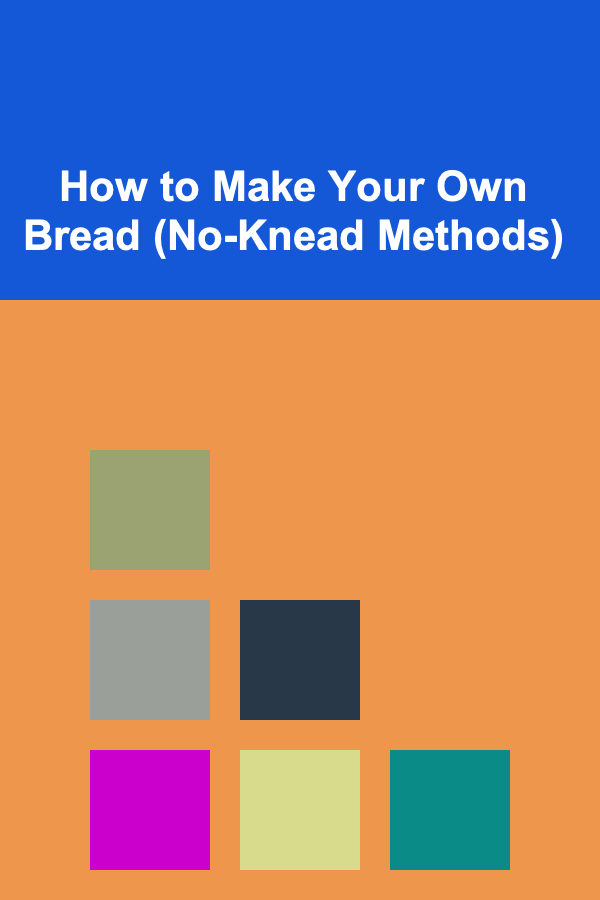
How to Make Your Own Bread (No-Knead Methods)
ebook include PDF & Audio bundle (Micro Guide)
$12.99$10.99
Limited Time Offer! Order within the next:

Baking bread at home is a rewarding experience. The scent of freshly baked bread wafting through your kitchen can fill your home with warmth and comfort. While bread making often conjures images of hours spent kneading dough and waiting for it to rise, there is an easier and less time-consuming method to achieve perfect homemade bread. Enter the world of no-knead bread.
In this article, we will delve into the art and science of no-knead bread-making. This approach eliminates the need for long kneading sessions, yet still yields a loaf with a crispy crust and chewy, airy interior. By understanding the basic principles and techniques of no-knead bread, you'll be able to bake delicious bread with minimal effort.
The Basics of No-Knead Bread
No-knead bread is a type of artisan-style bread that relies on long fermentation times rather than traditional kneading to develop flavor and texture. The long fermentation process allows the dough to rise slowly, breaking down the flour and gluten, and developing a complex flavor profile that makes no-knead bread so unique.
The beauty of no-knead bread lies in its simplicity. It requires only a few basic ingredients: flour, water, yeast, and salt. With a few minor adjustments and a bit of patience, you can create a loaf that rivals those made in professional bakeries.
Key Ingredients for No-Knead Bread
- Flour: The type of flour you use will affect the texture and flavor of your bread. All-purpose flour is most commonly used in no-knead bread, but you can experiment with bread flour (which has a higher protein content) for a slightly chewier texture. For a more rustic flavor, whole wheat flour can also be used.
- Water: Water is essential to hydrating the flour and activating the yeast. The temperature of the water should be lukewarm (around 100°F or 38°C), as hot water can kill the yeast and cold water will slow down the fermentation process.
- Yeast: Active dry yeast or instant yeast works well for no-knead bread. Instant yeast is often preferred because it doesn't need to be activated in water before being added to the dough. However, active dry yeast will also work fine; you'll just need to dissolve it in warm water first.
- Salt: Salt not only enhances the flavor of the bread but also controls the fermentation process. Too much salt can inhibit yeast activity, so be sure to measure carefully.
The Science Behind No-Knead Bread
To understand why no-knead bread works, we need to consider the role of kneading in traditional bread-making. Kneading is typically done to develop gluten in the dough, which provides structure and elasticity to the bread. However, in no-knead bread, the dough is allowed to rest for an extended period of time, often 12-18 hours, allowing the gluten to develop naturally through a slow fermentation process.
During this long fermentation, the yeast slowly consumes the sugars in the flour, producing carbon dioxide, which creates the bubbles that make bread rise. The long resting period also enhances the flavor of the bread, resulting in a richer, more complex taste than a quick-rise bread.
The result is a bread that has a chewy, airy texture and a crispy, golden-brown crust, despite not being kneaded. The key to success lies in the proper ratio of ingredients and giving the dough enough time to rest and ferment.
Step-by-Step Guide to Making No-Knead Bread
Now that you understand the basic principles of no-knead bread, let's dive into the process. Here's how to make your own no-knead bread from start to finish.
Ingredients
- 3 cups of all-purpose flour (or bread flour)
- 1 teaspoon salt
- 1/4 teaspoon active dry yeast or instant yeast
- 1 1/2 cups lukewarm water (about 100°F or 38°C)
Equipment
- Large mixing bowl
- Wooden spoon or dough scraper
- Clean kitchen towel or plastic wrap
- Dutch oven or heavy pot with a lid
- Parchment paper (optional)
Instructions
1. Mix the Dough
In a large mixing bowl, combine the flour, salt, and yeast. Stir to evenly distribute the ingredients. Gradually add the lukewarm water to the dry ingredients, mixing with a wooden spoon or dough scraper. You want the dough to be slightly sticky and shaggy but not overly wet.
Once the water is incorporated, use your hands to gather the dough into a ball. The dough should be rough and sticky, but don't worry about the lack of smoothness---this is normal for no-knead bread.
2. Rest and Ferment
Cover the bowl with a clean kitchen towel or plastic wrap. Let the dough sit at room temperature for about 12 to 18 hours. The dough will rise slowly and develop flavor as it ferments. During this time, the yeast will activate, and the dough will become more elastic.
The dough should double in size and be dotted with bubbles when it's ready to shape. It may also have a slightly tangy aroma due to the fermentation process.
3. Shape the Dough
Once the dough has fermented, it's time to shape it. Sprinkle a clean surface with flour or lightly oil your hands. Carefully transfer the dough from the bowl to the surface, being careful not to deflate it. Gently fold the dough over itself a few times to create a rough ball. You don't need to knead the dough at this stage; just bring the edges together.
If you prefer, you can shape the dough into a round loaf or a longer oval shape. It's up to you how you want your bread to look. Once shaped, cover the dough loosely with a towel and let it rest for another 30 minutes to an hour. This rest time allows the dough to rise further before baking.
4. Preheat the Oven
While the dough is resting, preheat your oven to 450°F (230°C). If you have a Dutch oven or heavy pot with a lid, place it in the oven while it preheats. The hot pot will create a steam environment that helps develop a crispy, golden crust.
5. Bake the Bread
Once the oven has reached the desired temperature, carefully remove the preheated Dutch oven from the oven. Line the bottom of the pot with parchment paper (if using), then gently place the dough inside. Be careful, as the pot will be extremely hot.
Cover the pot with the lid and return it to the oven. Bake for 30 minutes. After 30 minutes, remove the lid and continue baking for an additional 15-20 minutes, or until the bread has developed a deep golden-brown color and sounds hollow when tapped on the bottom.
6. Cool the Bread
Once the bread is baked, remove it from the pot and place it on a wire rack to cool completely. Allow the bread to cool for at least an hour before slicing. Cutting into the bread too soon can result in a doughy interior, as the steam inside the bread needs time to escape.
Tips for Perfect No-Knead Bread
- Hydration: The key to a successful no-knead bread is maintaining the right level of hydration. A higher hydration dough (more water) will create larger holes in the bread, resulting in an airier texture. If your dough seems too dry, you can add a little extra water during mixing, but be careful not to make it too runny.
- Flour Type: Experiment with different types of flour to achieve your desired texture. Bread flour will give your loaf a chewier crumb, while whole wheat flour will create a denser, more rustic loaf. A combination of both can yield the best of both worlds.
- Flavor Variations: You can add herbs, garlic, seeds, or dried fruit to the dough to customize the flavor of your bread. Simply fold in these ingredients during the initial mixing stage.
- Longer Fermentation: If you have the time, try letting your dough ferment for up to 24 hours. A longer fermentation time results in a more complex flavor profile, with slightly tangier and more aromatic bread.
- Dutch Oven or Not?: While a Dutch oven is ideal for trapping steam and ensuring a crispy crust, you can also bake no-knead bread on a baking sheet. If you don't have a Dutch oven, create steam by placing a pan of water in the oven or spritzing the bread with water before baking.
Troubleshooting No-Knead Bread
While no-knead bread is relatively simple to make, a few common issues might arise. Here's how to fix them:
- Dense Loaf: If your bread is too dense, it may be a sign that the dough was not hydrated enough or the fermentation time was too short. Try adding a bit more water and letting the dough ferment for a longer period.
- Flat Bread: If your bread is too flat, the dough may not have risen enough during fermentation. Be sure to give the dough enough time to rise before shaping and baking.
- Overly Hard Crust: A hard, overly thick crust could be the result of overbaking or using too high a temperature. If your crust is too thick, reduce the baking time slightly or lower the oven temperature by 10-15 degrees.
Conclusion
No-knead bread is a simple and rewarding way to bake homemade bread with minimal effort. By using basic ingredients and a long fermentation time, you can create delicious, crusty, and chewy bread that rivals anything you can find in a bakery. The beauty of no-knead bread is that it requires little hands-on time but yields a loaf that's perfect for toasting, sandwiches, or enjoying with a spread of butter.
With patience and practice, you'll soon be able to bake your own perfect loaf of no-knead bread whenever the craving strikes. Happy baking!

How to Avoid Common Budgeting Mistakes While Managing Home Expenses
Read More
How to Declutter Your Hobby Room for a Fresh Start
Read More
How to Plan a Themed Home Party Everyone Will Love
Read More
How to Prepare for a Financially Stress-Free Holiday Season
Read More
How to Support First Responders' Mental Health
Read More
10 Tips for Maintaining a Good Relationship with Your Landlord
Read MoreOther Products

How to Avoid Common Budgeting Mistakes While Managing Home Expenses
Read More
How to Declutter Your Hobby Room for a Fresh Start
Read More
How to Plan a Themed Home Party Everyone Will Love
Read More
How to Prepare for a Financially Stress-Free Holiday Season
Read More
How to Support First Responders' Mental Health
Read More